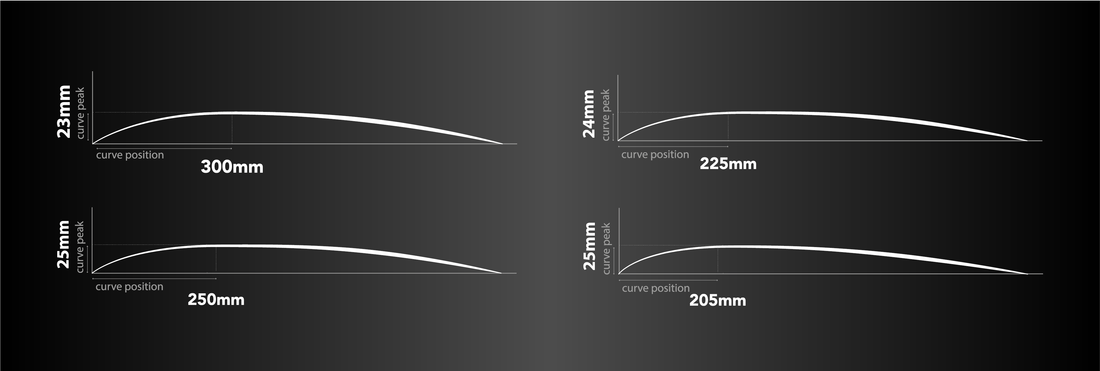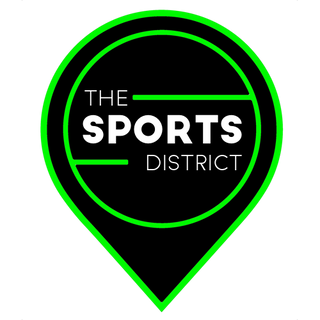
Hockey sticks come in a variety of shape profiles (often referred to as bows, moulds or bends) and lay-ups (sometimes called compositions or constructions). While different brands use different terms to describe the various options in their ranges, the underlying principles have some commonality across the market.

Stick profiles can generally be put into three categories, generically known as Mid, Late and Extra Late Bows, with the term referring to the position of the highest point of the bow (bend) rather than the size of that bow. Some brands will use their own terms (generally for marketing purposes) to describe shapes and adapt around these basic classifications by varying the exact position and size of the bow, but as a simple basis to use as a starting point this works well.
You may also see brands add grooves to the playing surface along with sometimes deviations from the basic rounded profile usually associated with the back of the stick. Any groove, channel or indentation on the playing surface (the front side) of the stick that alters this surface from a traditional flat face will have an impact on the playing style of the stick, as described below. Deviations from a rounded profile on the back of the stick would usually lay claim to increasing torsional or linear stiffness, specific claims by manufacturers that may or may not have merit.
FIH (International Hockey Federation) has rules governing the shape of the stick that all manufacturers are required to comply with. The reality is that below international level and the top level of club hockey you will rarely see officials checking sticks for compliance, but nonetheless due to the costs of moulds and manufacturing no brand would knowingly look to produce a non-compliant stick.
The key rules in terms of shape concern the maximum height of a bow (25mm) and the lowest position that the apex of the bow can be from the base of the head (200mm). Usually brands would look to work inside these limits so as to allow for the vagaries of the stick testing process employed by FIH!
In general terms, here are some guidelines as to the positioning of the main bow classifications:
Mid bow - usually placed around 300mm from the base of the head
Late bow - usually placed around 250mm from the base of the head
Extra late bow - usually placed around 205mm from the base of the head
While the height of the bow will have a bearing on the playing characteristics of the shape and how it influences the player the position of the bow is a more significant factor. The bow position of the stick will determine where the stick will help the player and where the player has to help the stick in order to perform a full skill set.
The way to understand and assess these differences and assess the options is to begin with a starting point of the basics, i.e. trapping, pushing and hitting the ball. These are skills that every player must have as the cornerstone of their game and perfect execution of them requires a flat and square connection with the ball in its purest sense. The position of the bow influences the placement of the player’s hands to enable this basic starting point.
To approach and assess the range of options it helps to imagine a sliding scale where you have the mid bow at one end and the extra late bow at the other.
The mid bow shape is often regarded as “straighter” in simple terminology. This means that the face of the stick will have a flat and square connection with the ball with the hands / wrists in a conventional position, which is left hand over the stick head when addressing the ball, which always has an optimum position of being in line with the player’s head and around the front foot. The lower the high point of the bow is pushed down the stick the more the player must adjust their hand / wrist position to move in front of the stick head (and ball) to maintain a flat and square contact. The ball should never be moved back in the player’s stance to compensate for a lower bow since that will mean contact with the ball would be on the downswing rather than through-swing when hitting the ball, control would be lost when pushing and balance / vision would be affected when trapping.
If the player does not make this adjustment as the bow moves lower the typical consequence when hitting or pushing the ball is a loss of control in direction and trajectory; to varying degrees the ball will go up and left. Similarly when trapping the ball it will lift off the ground and possibly come in towards the player’s legs / feet.
So at one end of the scale then the mid bow is shaped to help a basic skill set, hitting, pushing, trapping etc. With this shape you can perform and control the basics without having to concentrate too much on hand / wrist position and can keep your hands in the orthodox position, i.e. positioned in line with the stick head. However, if you want to perform some of the more dynamic skills (3D work, wide angle ball movement, backhand, overheads etc) then you have to work a bit harder to drop your wrists and create an angle to enable a wider range of ball movement, i.e. 3D dribbling, wider angle dragging or dribbling, flicking etc and also get your hands much lower to the ground to get the stick flat for backhand hitting.
Shift to the other scale and the extra late bow and you have a shape that is geared up to help more dynamic skills and a wider range of ball movement but you have to make adjustments to perform the basics well. The bend position means 3D and wide angle ball movement is easier without you having to alter body / hand / wrist position as the shape creates more extreme stick head angles through the bow position. You can perform backhand with a more upright angle to the ground since the contact point will be square to the ball earlier than with a higher bend (in fact if you try and backhand with a stick parallel to the ground, i.e. flatter, you will not get the right connection and will hit with the back of the stick). Of course overheads and drag flicks are helped massively too. The flip side is that you have to work your wrists and arms to get your hands ahead of the stick head to present a flat face to trap the ball and keep hits and pushes flat and straight.
Everything between these extremes of the scale will have a graduated assistance along the scale, which makes a late bow the ideal shape for a full skill set in the modern game with limited adjustments by the player to perform at either end of the scale.
As mentioned above, some profiles will have a groove or channel across part of the playing surface of the stick, typically the lower third of the playing area and the head. The purpose is to add to the control and execution of skills involving lifting the ball and also for generally dribbling the ball. The flip side to this is that the area of the head / shaft where the stick makes flat and full contact with the ball is dramatically reduced in size, so the player must be very precise in the basics of trapping, hitting and pushing to execute those skills correctly.
Whatever you want from your game it is vital to remember that no stick is a magic wand. The stick will help the player with some things and the player must work to enable the rest. it is very much a partnership.
